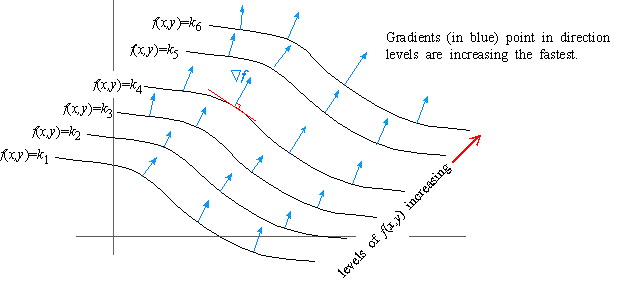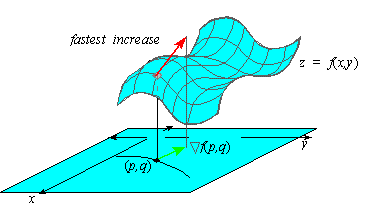Properties of the Gradient
If we let q denote the angle between Ñf and a
given unit vector u, then
|
Duf = || Ñf|| || u|| cos( q) = || Ñf|| cos( q) |
|
since || u|| = 1. Thus, the directional derivative is
largest when q = 0, which is in the direction of Ñf, and is
smallest when q = p, which is in the direction of -Ñf.
Theorem 7.2: The slope ( Duf) ( p) of the tangent line to a vertical slice of z = f(x,y) through ( p,q,f( p) ) is
greatest in the direction of Ñf( p) and
is smallest in the direction of -Ñf( p) .
We say that Ñf( p,q) is the direction of
steepest ascent for the surface z = f( x,y) at (p,q) . Analogously, -Ñf( p,q) must the direction of steepest descent or direction of least resistance at
the point ( p,q) .
Moreover, when u is the direction vector for Ñf, then u = Ñf/||Ñf||, so that
|
Duf = Ñf · |
Ñf
||Ñf||
|
= |
||Ñf||2
||Ñf||
|
= ||Ñf|| |
|
Similarly, if u is in the direction of -Ñf, then Duf = -||Ñf||. Also, the corresponding
tangent vectors to the surface are
|
|
|
|
vinc = |
|
 |
fx
||Ñf||
|
, |
fy
||Ñf||
|
,||Ñf|| |
|
 |
| |
|
| vdec = |
|
 |
- fx
||Ñf||
|
, |
-fy
||Ñf||
|
,-||Ñf|| |
 |
|
|
|
This is important in many numerical routines.
EXAMPLE 4 How fast is f( x,y) = x2+y3
increasing at ( 2,1) when it is increasing the fastest?
Solution: To begin with, Ñf =
á2x,3y2
ñ . Moreover, f is increasing the fastest when u is in the direction of Ñf( 2,3) =
á4,3
ñ , and in this direction, we have
|
( Duf) ( 2,1) = ||
á4,3
ñ || = 5 |
|
(The notation ( Duf) ( p,q) means the
directional derivative Duf evaluated at the point (p,q) . )
Moreover, given a collection of increasing constants k1 < k2 < k3 < ¼, the set of level curves
|
f( x,y) = k1, f( x,y) = k2, f(x,y) = k3, and so on |
|
forms a family of level curves in the xy-plane in which the levels are
increasing. It then follows that Ñf( p,q) points in the
direction in which the levels are increasing the fastest, and -Ñf( p,q) points in the direction in which the levels are
decreasing the fastest.

EXAMPLE 5 In what direction are the levels of f(x,y) = x3y increasing the fastest at the point ( 2,3) ?
Solution: The levels of f are increasing the fastest in the
direction of Ñf( 2,3) . Since Ñf =
á3x2y,x3
ñ , we have Ñf( 2,3) =
á 36,8
ñ . Thus, the levels of f are increasing
the fastest in the direction
|
u = |
Ñf( 2,3)
|| Ñf(2,3) ||
|
= |
á 36,8
ñ
||
á 36,8
ñ ||
|
= |

|
|
9
|
, |
2
|

|
|
|
Check Your Reading: How fast are the levels increasing at
right angles to Ñg?

